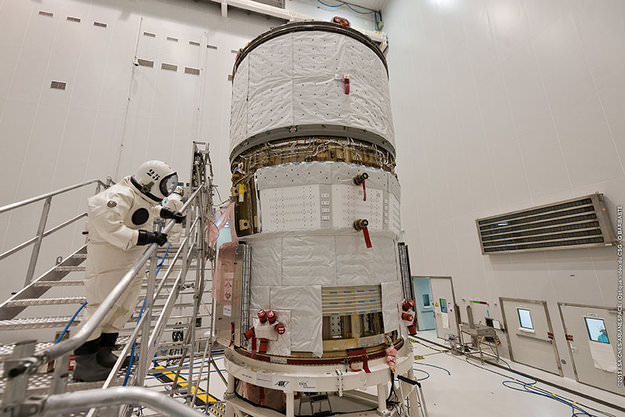The next European cargo mission to the International Space Station is preparing for launch, and in this new image, a fuelling operator at Europe’s Spaceport in French Guiana inspects the ATV-4 Albert Einstein as it is filled with propellant. Launch is currently scheduled for June 5, 2013 on an Ariane 5ES rocket to bring about 7 tons of cargo the ISS, including fuel to give the space station an orbital re-boost.
These Automated Transfer Vehicles (ATVs) bring other supplies such as equipment, experiments, water, air, nitrogen, oxygen and fuel.
As the ISS circles Earth, it slowly loses altitude, and occasionally needs a boost to keep it in the proper orbit. ATVs, Progress resupply ships and the thrusters on the Zvezda service module are used to re-boost the station; Soyuz spacecraft are also used “in a pinch” said Johnson Space Center News Chief Kelly Humphries, but they mainly want to save the Soyuz fuel for the departing crew heading back to Earth.
Watch this video as astronaut Jeff Williams demonstrates the acceleration experienced inside the cabin during a reboost on January 24, 2010 (the acceleration starts about 3:50 in the video):


Interesting enough, a 1 G acceleration would have to be one heck of a rocket boost! I have heard that a centrifuge may one day be installed on the space station like in the movie 2010 on the Russian freighter.
I have to say that I would have a lot easier time accepting the cost of the space station if it weren’t so darn dependant on Earth.
I understand that there will be certain things that we are simply unable to do in space so some level of support and supply from the planet is necessary. However wouldn’t an effort at making the ISS as autonomous as we can set us up for our long term goals of exploring Mars and beyond? With the worlds economies the way they are I don’t see the world putting another structure in space in the next 50 years realistically. NASA has spoken of a platform on the far side of the moon which could be manned but wouldn’t require a full time crew. What are the odds of that actually happening? Slim to none I’d wager..
I think that if the ISS was going to be used for significantly longer time than it currently is, that may hold some merrit.
Put some hydroponics for food and water as well as assisting with liquid and solid waste disposal and CO2 recapture. I’m sure it wouldn’t be too hard to set up a system that uses algee to capture nitrogen and CO2 from waste water in preperation for further recycling.
However, the expense would probably not be worth it in the short amount of time remaining for the ISS.
You are right unless there was a commitment from the partner nations for a minimum of another decade (preferably 2) it wouldn’t make sense retrofitting it.
It is a real shame it wasn’t designed that way from the outset. Instead it appears that the ISS was really just an upgrade to MIR. A real missed opportunity IMHO.